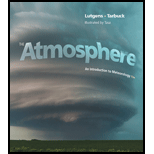
The reason why low clouds are much more likely to produce precipitation than middle or high clouds.
Answer to Problem 1GST
Low clouds such as nimbostratus clouds are associated with warm fronts where warm, moist air overrides the colder air at the surface. They are the main clouds that result in precipitation.
Explanation of Solution
Various types of clouds include high clouds, middle clouds, low clouds, and clouds of vertical development. High clouds contain ice crystal or supercooled water droplets that are formed in the coldest and highest areas of the troposphere. They are formed with bases above 6000 meters. All high clouds are thin, white, and are made up of ice crystals due to their low atmospheric temperature and a small amount of water vapor present at high altitudes.
Middle clouds are located at the altitude from 2000 to 6000 meters and contain water droplets or ice crystals depending on the temperature of the atmosphere and the time of the year. Low cloudsare located at an altitude of 2000 meters and are composed of water droplets.The clouds whose bases originate in the lower stratosphere and extend to the middle or high altitudes are referred as the clouds of vertical development.
Want to see more full solutions like this?
Chapter 5 Solutions
The Atmosphere: An Introduction to Meteorology (13th Edition) (MasteringMeteorology Series)
- Discussion Question: Essentials of Geography A+ Chapter 1 does a nice job introducing the Physical Earth Sciences with the traditional scientific methods and systems. However, Physical Geography exemplifies understanding spatial patterns. For example, we could research an area's cases of West Nile Virus using a table filled with location and number of deaths and it would be useful. However, an even better way to look at the information in order to search for an underlying pattern and an explanation would be to map the data. For the Chapter 1 Discussion, find a thematic map from your house, the Newspaper, the Internet, the textbook, or wherever you find one! Be sure to include the source such that any of us can get our hands on the same information/map. First DESCRIBE the patterns that you see. Then, INTERPRET the reasons for the pattern. For example,the figures above and below are maps with information plotted. Remember, descriptions are not arguable. Descriptions are factual…arrow_forwardWhat are the latitude and longitude of Points A through D on the figure below? Please remember latitude is given first and is always north or south of the equator. Then, longitude is given next and is always east or west of the prime meridian. Upload your answers as a file to the Assignments section.arrow_forwardConsider Cronon’s study of wilderness, as discussed by Kanazawa (2023). In what ways, if any, would it have been appropriate for Cronon to have used quantitative methods in his study of the concept of wilderness, and to what end? Why were qualitative methods particularly appropriate for the study, given the nature of his research topic?arrow_forward
- Google Earth Assingment HW 2 Earth 1050arrow_forward''Discuss the role of natural disasters in the global epidemiology of gastroenteritis over the last 10 years.'' Including case studies of natural disaster events and gastroenteritis outbreaks (must be within the past 10 years)arrow_forwardWho wrote "there is no one is not better who has spent time in the presence of stones"arrow_forward
- I need some help for Medical Microbiology , 'Discuss the role of natural disasters in the global epidemiology of gastroenteritis over the last 10 years.'arrow_forwardOrder this what come first 1.evaporation 2.transpiration 3. Warm air rises 4. Condensation 5. Precipitation 6.surface run off 7. Infiltration 8. Ground water storearrow_forwardI want to research desertification from 2020 to the presentarrow_forward
- How do i know where the arrows should point?arrow_forwardWhy is the Atlantic Ocean the saltiest ocean on Earth? In your explanation, use the terms “evaporation,” “precipitation,” “trade winds,” “Central America,” and “Pacific Ocean”.?arrow_forwardAt the large scale of the major ocean basins, do ocean currents tend to flow in a cyclonic or anti-cyclonic direction? How is this evidenced in the map of average sea-surface temperatures belowarrow_forward
 Applications and Investigations in Earth Science ...Earth ScienceISBN:9780134746241Author:Edward J. Tarbuck, Frederick K. Lutgens, Dennis G. TasaPublisher:PEARSON
Applications and Investigations in Earth Science ...Earth ScienceISBN:9780134746241Author:Edward J. Tarbuck, Frederick K. Lutgens, Dennis G. TasaPublisher:PEARSON Exercises for Weather & Climate (9th Edition)Earth ScienceISBN:9780134041360Author:Greg CarbonePublisher:PEARSON
Exercises for Weather & Climate (9th Edition)Earth ScienceISBN:9780134041360Author:Greg CarbonePublisher:PEARSON Environmental ScienceEarth ScienceISBN:9781260153125Author:William P Cunningham Prof., Mary Ann Cunningham ProfessorPublisher:McGraw-Hill Education
Environmental ScienceEarth ScienceISBN:9781260153125Author:William P Cunningham Prof., Mary Ann Cunningham ProfessorPublisher:McGraw-Hill Education Earth Science (15th Edition)Earth ScienceISBN:9780134543536Author:Edward J. Tarbuck, Frederick K. Lutgens, Dennis G. TasaPublisher:PEARSON
Earth Science (15th Edition)Earth ScienceISBN:9780134543536Author:Edward J. Tarbuck, Frederick K. Lutgens, Dennis G. TasaPublisher:PEARSON Environmental Science (MindTap Course List)Earth ScienceISBN:9781337569613Author:G. Tyler Miller, Scott SpoolmanPublisher:Cengage Learning
Environmental Science (MindTap Course List)Earth ScienceISBN:9781337569613Author:G. Tyler Miller, Scott SpoolmanPublisher:Cengage Learning Physical GeologyEarth ScienceISBN:9781259916823Author:Plummer, Charles C., CARLSON, Diane H., Hammersley, LisaPublisher:Mcgraw-hill Education,
Physical GeologyEarth ScienceISBN:9781259916823Author:Plummer, Charles C., CARLSON, Diane H., Hammersley, LisaPublisher:Mcgraw-hill Education,





